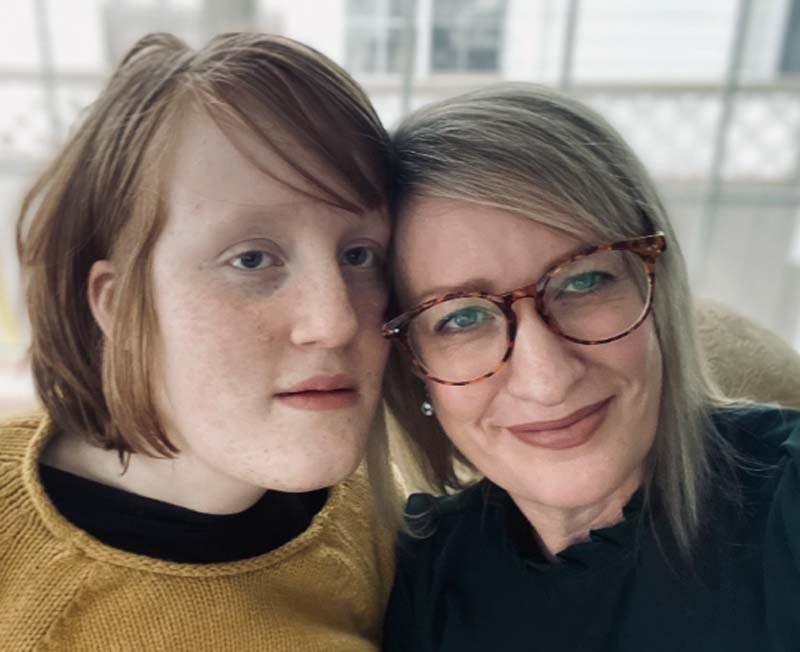When Kim Strandberg’s daughter Avelyn was just shy of a year old, she knew something was amiss.
Avelyn wasn’t developing the same way as her three older boys and so she spent the next 13 years chasing all sorts of rabbit holes trying to figure out what underlying issue her daughter may have.
Avelyn, who is non-verbal, received an autism diagnosis at the age of three, although Strandberg says it was understood that she had autism either in conjunction with someone else, or as part of a bigger issue.
“Ava and I have been through the gambit at B.C. Children’s Hospital,” said Strandberg.
“I followed everything that I could, but I never got an answer as to what my child has,” she said, adding she was told science was progressing at a rapid rate and to wait for answers.
“What science has been able to do now is whole exome sequencing.”
Exome sequencing is a scientific technique that reads important pieces of a person's genetic code to understand symptoms of a disease. And because everything else the family had tested for came back negative, Strandberg was approved by MSP to do whole exome sequencing, which was conducted through blood tests at a lab in Finland.
The report came back stating that Avelyn had a mutation in what's known as the MAST-1 gene, essential for brain development. Her mutation is considered ‘de novo’, meaning it wasn’t inherited from either her mother or father.
MAST-1 is a gene involved in encoding microtubule-associated protein that is expressed in neurons in the developing brain. It 's one of 20,000 different genes that make up our genetic information.
“The science is expanding so quickly but we don’t always know what it means,” said Strandberg, adding that although a mutation with this gene has been identified, science hasn’t been able to figure out how this gene affects different abilities in the brain.
Strandberg says there’s only nine other people in the world, that she’s aware of, who have been found to have a mutation in the MAST-1 area.
However, Avelyn is the only one of the recorded cases to have a deletion at the MAST-1 site rather than a duplication.
“The report will come back and say it's of unknown clinical significance, which means just wait until science catches up, and I am not prepared to do that,” said Strandberg.
A variant of uncertain significance is a change in a gene where there’s been no other cases reported with that specific spelling error or genetic variant.
“Part of the issue in some of this new testing is that we're learning as we're going. It is not always possible to give a complete answer at any given time, depending on what the information is,” said David Koehn, genetic counsellor at the Provincial Medical Genetics Program.
“When it’s a variant of uncertain significance, even if it’s in a suspicious gene, you still need other cases that are exactly similar and have the same changes to say, ‘Oh yes, that actually goes together here.’”
Koehn says there always has to be supporting evidence because it could always just be a benign change in a gene that has no effect.
“The conclusion at this point, in terms of variants in MAST-1, is it may give rise to a spectrum of neuro-developmental diseases but that the spectrum may be still expanded with further research.”
Strandberg says she’s frustrated that she’s had to chase answers for 13 years, and wonders how many other people may around the world may unknowingly have a similar genetic variant.
She says she had to be an advocate and champion for Avelyn just to get to this stage of information.
“There could be hundreds or thousands of children whose parents firmly believe there's something else also going on, that have not been tested.”
Strandberg said she doesn't want to sound alarmist to families with children on the spectrum, "but if you feel there’s something coexisting as far as dysmorphic features it would be worth exploring with your general practitioner."
Whole exome sequencing is cutting-edge technology in genetics, but it has only been in use clinically for about five years.
In order to expand the research, Koehn says an individual has to come to medical attention, undergo testing, and then that information has to be put into databases so it can be reported in scientific literature — all of which takes time.
“She is the only person in the world to carry this, that we're aware of at the moment," said Strandberg. "But my feeling is that there are going to be a lot more people that most likely will come out in the future that have an irregularity in the same region."
“It can't possibly be that she's only one out of eight billion people on the planet," she said.
However, because the mutation is so rare and this type of genetic testing so new, Strandberg worries there won’t yet be funding for research facilities to study this gene.
“I would like to see obviously more money thrown at this because it's quite possible that you could have millions of people around the world and elsewhere who have a MAST-1 gene irregularity,” she said, adding that, with funding, research could start moving forward.
Strandberg’s hope is that by increasing awareness of Avelyn’s story, it may eventually lead to further testing and or best case outcomes for her and her life.



